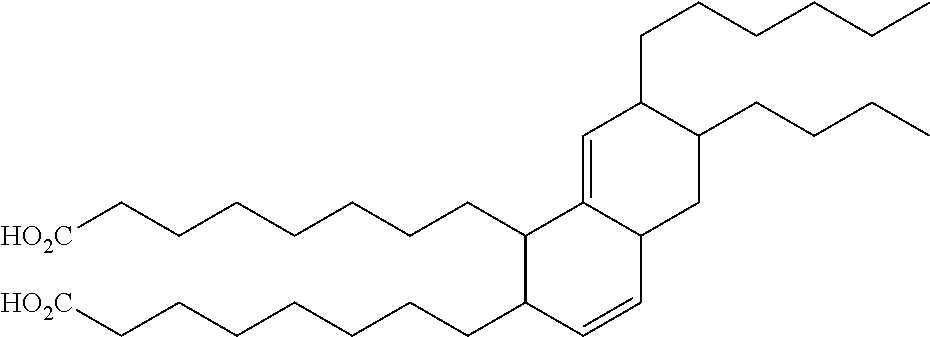Compositions comprising unsaturated fatty esters and uses thereof
- Summary
- Abstract
- Description
- Claims
- Application Information
AI Technical Summary
Benefits of technology
Problems solved by technology
Method used
Image
Examples
example 1
Odor Suppression
[0101]Head space analysis testing was used to measure the quantity of VOCs emitted by the compositions described herein. Head space analysis is a technique for using gas chromatography for quantifying the vapors in the gas above the compositions described herein. The procedure involves the extraction of a volume of the equilibrium gas over the sample (usually about 10 ml) by a syringe through a vial containing a bed of an appropriate absorbent. The vial is the placed in line with a gas chromatography column, the vial heated and the vaporized sample swept on the column and the components of the gas are separated. This technique includes a GC-MS. 100 ml samples of each of preservative solutions are brought to 10 F above our operating temperatures to determine what gases are present in the atmosphere above the preservative solutions.
[0102]In this testing for the efficacy of the odor suppression, naphthalene is used as an indicator for odor. A wood preserving operation e...
example 2
Stability of Creosote-Based or PCP-Based Preservative Solutions Containing Either Biodiesel or Unsaturated Fatty Esters
[0104]The stability of creosote-based and PCP / diesel-based preservative pollutions, each having either biodiesel or unsaturated fatty ester additives was measured. The biodiesel or unsaturated fatty ester additives esters were mixed into the creosote-based and PCP / diesel-based formulations using a standard magnetic stirring system. The resulting creosote-based formulations were heated to operating temperatures of about 100° C. and then cooled back to storage of about 70° C. The resulting creosote-based formulations were heated to operating temperatures of about 70° C. and then cooled back to storage of about 50° C. The formulations were checked for stratification and / or the formation of sludge at both temperatures. All mixing was done in a standard 2 liter beaker with the volume adjusted to 1.5 liters.
TABLE 11Stability of creosote formulations having biodieselor uns...
example 3
Properties of the Creosote / Unsaturated Fatty Ester Formulations
[0106]Experiments were undertaken to determine that the addition of unsaturated fatty acid esters to creosote did not materially affect the properties of the creosote as per the AWPA 2012 specification P1-P13-09 and P2-09. The Table below compares the physical properties of a creosote formulation with and with out a 10% mixture of linoleic, oleic, linolenic and arachidonic unsaturated fatty methyl esters (1:1:1:1 ratio).
TABLE 13P2-09 Standard for Creosote Solution1:1:1:1 Blendof unsaturatedCreosote *Creosote **fatty esters (10%)Water Content (% by>1.5>3.0>1.5volume)Material insoluble in3.5>4>3XyleneSpecific Gravity @38° C.(compared to Water@15.5° C.)Whole Creosote>1.080>1.095>1.130>1.130Fraction 235-315° C.>1.025>1.025Fraction 315-355° C.>1.085>1.093DistillationUp to 210° C.Up to 235° C.Up to 315° C.>32.0>32.0Up to 355° C.>52.0>52.0Creosote * is new creosote that has not yet been in contact with wood.Creosote ** is creos...
PUM
| Property | Measurement | Unit |
|---|---|---|
| Temperature | aaaaa | aaaaa |
| Time | aaaaa | aaaaa |
| Pressure | aaaaa | aaaaa |
Abstract
Description
Claims
Application Information
 Login to View More
Login to View More - Generate Ideas
- Intellectual Property
- Life Sciences
- Materials
- Tech Scout
- Unparalleled Data Quality
- Higher Quality Content
- 60% Fewer Hallucinations
Browse by: Latest US Patents, China's latest patents, Technical Efficacy Thesaurus, Application Domain, Technology Topic, Popular Technical Reports.
© 2025 PatSnap. All rights reserved.Legal|Privacy policy|Modern Slavery Act Transparency Statement|Sitemap|About US| Contact US: help@patsnap.com



